
A number of shoulder problems or syndromes cause restriction of movement in the shoulder joint complex. Limitation can be due to pain and or actual resistance or restriction of joint movement. Often the joint fluid or capsule / membrane around the joint can become tight and ʻstuckʼ together. These problems can range from Frozen Shoulder, Adhesive Capsulitis, simple Capsulitis, Sub-Acromial Bursitis, Painful Arc Syndrome & Tendonitis.
These problems often benefit from exercises that are intended to mobilise and restore function and range of movement. These exercises need to be performed gradually, very gently at first, with a small number of repetitions and sets, gradually increasing as improvement is observed. Exercises should be pushed to the point of pain, held for a few seconds and then pushed a little more and then repeated a third time. This routine can be repeated 2-3 times per day, once some improvement is observed otherwise once per day initially is sufficient.
NB If increased pain, symptoms or further loss of movement occurs then stop the exercise and consult your osteopath.
NB Often these exercises can be performed in conjunction with using an ice pack before and after the exercise. The ice pack should not be applied directly to the skin, wrap the ice pack in a thin towel and kept in contact for only 5-10 minutes.
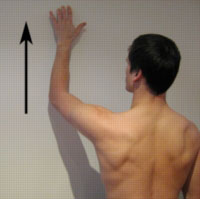
Patient stands facing the wall at arms length or a little closer. place finger tips against wall and walk up. At painful point stop wait a few seconds and try a little further. repeat 3-4 times, improvement comes gradually. Repeat with patient standing sideways onto the wall, bad arm to the wall and repeat as above.
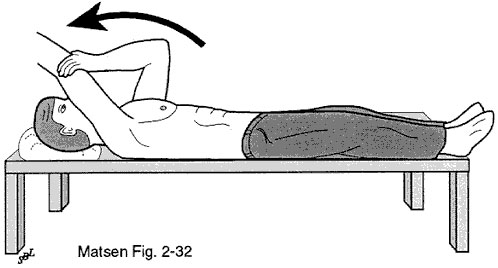
Patient lies on back bad arm encouraged with help from good arm to push above and over patients head. Push gently to pain, hold a few seconds and then push further, repeat 3-4 times.
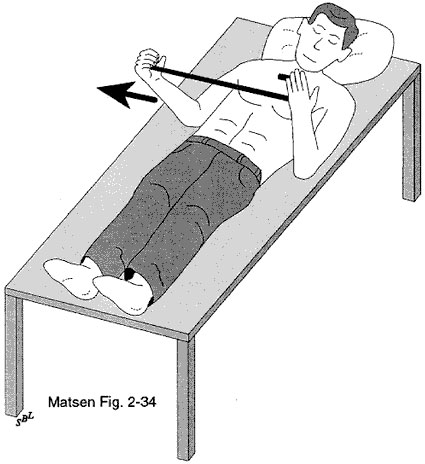
Patient lies on back, patients arms against the table with forearms at 90 degrees, use a walking stick against palm of bad hand and good hand pushes opposite end of the walking stick to encourage the external (outward) rotation movement. Push to the point of pain, hold and push some more, repeat 3-4 times.
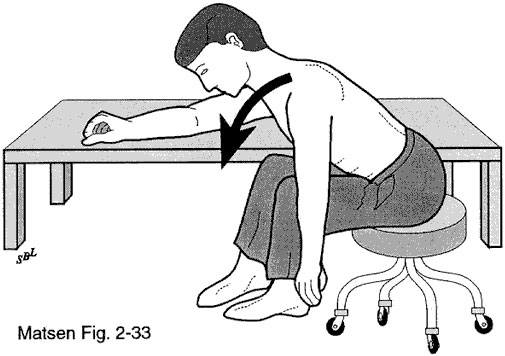
Patient sits at the side of a table with bad shoulder against the table. Place the bad arm forearm onto the table and gently lean forwards, over and downwards to the point of pain, hold and push some more, repeat 3-4 times.
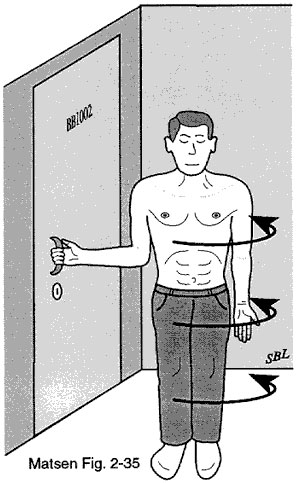
Patient stands side onto a closed door with the bad arm towards the door. The bad arm hand grips the handle of the closed door and then turns his/her body away from the closed door to the point of pain, hold and turn away more, repeat 3-4 times.
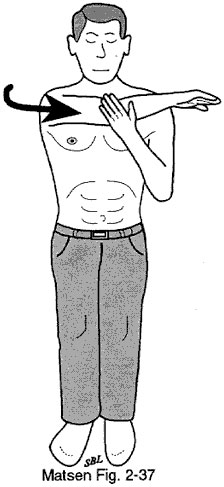
Patient standing or sitting uses the good arm to help encourage the bad arm across the front of the patients body to the point of pain, hold and repeat 3-4 times.
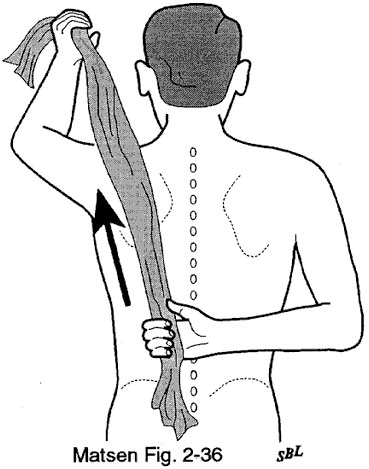
Patient is standing but this can be done sitting, the bad arm grips the towel at a comfortable point at the top or bottom end of the towel drying position. The good hand arm then reaches to the other end of the towel and reaches as far as can towards the bad arm hand and grips the towel. The good arm hand ONLY then pulls whilst the bad arm has to follow (is pulled) to the point of pain, hold and repeat 3-4 times. Then swap hands round and repeat.
Daryl Herbert's instructional videos provide a visual and audible description of Osteopathic Minimal (short) Lever Mid Range Manipulation Techniques, for osteopaths, physiotherapists, manual therapists, mid to senior level students, graduates and post graduates. Techniques demonstrated look at the basic spinal regions, the spinal junctions, the sacro-iliac joints, ribs and the lower and upper extremity joints.
The new Serola Sacroiliac Back Support Belt are used in thousands of NHS clinics countrywide...
Read More
Goldilocks pillows come in 5 different heights. The height of the pillow is measured as...
Read More
Receipts can be provided for your health insurance...
Read More